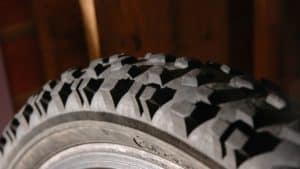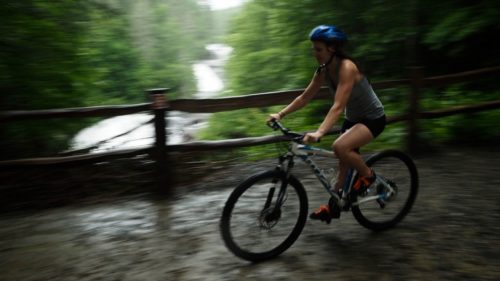Riding for long amounts of time takes the right type of setup for any rider. Without taking the time to get the right fit, the right style, and all the other adjustments, no bike ride will end up being too long.
The question is, can a mountain bike actually be used for longer rides? While some hate the idea of riding on a heavier bike with wider tires, others welcome the challenge. It is about the only option some have, especially if they are off-road most of the ride.
Mountain bike rides differ quite a bit depending on terrain, weather, riding experience, and more. Anything over 50 miles in one day is considered a success.
The easier the terrain, the more miles riders can log. Riding for too long in one particular day can force a person to need a day or two to recover before going out again.
Why Are Mountain Bikes Great Options For Long Rides?
Some people scoff at the idea that they would ever use a mountain bike for a longer ride. However, it has its place in the biking industry, and anything off-road is perfect for these options to tackle.
The only way a rider will pull off a long ride off-road is to have a mountain bike option to rely on. A road bike will instantly become too unstable, causing a lot of indecision for even the most experienced long-distance riders.
Mountain bikes come in all shapes and sizes, so finding the right solution takes a little time. For the most part, riders on pretty tame terrain will want a road bike type of setup with mountain bike tires.
If it looks extremely difficult to get through with a standard bike, a more aggressive design is necessary. Riders might not go as fast, but they will be secure and safe during the ride.
There is also something to be said for the build of a mountain bike compared to other options out there. Instead of necessarily having a very aggressive setup, most will love the more relaxed feel of a mountain bike overall.
That might not mean much as far as speed is concerned, but it helps with long and steady rides to pound out miles.
Some people can only go so far on a road bike because they do not like how their body has to stretch out in a certain way. Mountain bikes have a more relaxed geometrical setup in general.
When Does a Different Bike Make Sense For Riding a Long Distances
Mountain bikes are great overall options, but they might not be ideal in certain situations. Most notably, they are the best when it comes to riding on flat, even terrain for a long period of time. Instead, going with a road bike will make it easier to log miles, and go faster.
If it is very light off-road biking, a hybrid or gravel bike could be slightly easier to put a lot of miles in as well. This is because a mountain bike usually digs into the terrain a little more, so it starts to be more challenging to get through.
With all that said, plenty of people have a mountain bike only, and they make it work. It is all about how fast a person wants to push the pace, and if they are willing to make sacrifices when riding with others.
How to Make a Long Mountain Bike Ride More Comfortable?

If the goal is to log a lot of miles on a mountain bike, a person should make sure that they do everything possible to make the bike feel extremely comfortable.
There is nothing worse than trying to put a ton of miles in while being uncomfortable very early on in the start. It causes people to ultimately hurt themselves more and more, even if it is just some light straining in the beginning.
Get the Bike Sizing Right
There are many different adjustments a person can make with a mountain bike before going on a long ride. Start by checking the reach, and seeing what is most comfortable.
Reach is looking at the horizontal distance from the bottom bracket, all the way to the handlebars. Flexibility plays a major role in this, but the size of a person’s torso also matters.
No one wants to stretch too far when they are reaching, because that can put pain in the neck, shoulders, back, and more.
Even a slight stretch is going to make a difference in a long ride. It will prevent a person from bouncing back quickly, and it could put some unnecessary wear and tear on the body in general.
Handlebar height also makes a pretty big difference in getting the fit correctly for a mountain bike. This will affect just how high the handlebars are in relation to a rider.
If the handlebars are too far down, it can put a strain on the hamstrings and lower back. Most mountain bikes do a pretty good job of having riders in an upright position, but some of the racing options will be a little more like a road bike.
Those who train a lot will be just fine, but people getting used to a setup like this might not be ready to go.
Find the Perfect Saddle

During a long mountain bike ride, no one is going to be out of the saddle the entire time. It just makes no sense, and it can wear a rider down in a hurry.
Because that is the case, it is important to ensure that the saddle is as perfect as possible for an individual. Some people might be perfectly fine with the stock option, but the vast majority are going to be on a hunt to find their own saddle that works the way it should.
Pain in that part of the body can really be detrimental for anyone trying to log a ton of miles at once. Every person is different, so the stock option is not going to be built for every different type of rider.
The best way to figure things out is to try out some sample options that are available in a lot of bike shops. It also helps to read recommendations online and even take measurements to ensure that everything fits a particular body.
A lot of manufacturers are starting to realize that to convince shoppers looking around, they should offer a more customized solution for a saddle.
That is why they will offer in exchange for those who want a particular fit. Some people will have it ready to go right out of the showroom, while others will need a couple of weeks to figure out what works for them and what is not.
Once the new saddle is on, getting the right saddle height also makes a huge difference. This needs to balance out with the handlebars so that everything feels as comfortable as it should.
The last thing anybody wants to feel is the fact that they are stretched out in any one particular area of their body. Everything from the height to the angle will be a difference-maker.
Lower Tire Pressure

Lower tire pressure in a mountain bike is viewed as a pretty smart thing overall as far as comfort is concerned. While some believe that they are going to slow down, comfort is sometimes viewed as more important than speed.
It does not need to be a drastic change, but even dropping a few pounds in pressure will be noticeable. Again, it all depends on the terrain a rider is on to make an exact decision.
On flat terrains, it makes sense to go in the opposite direction and increase tire pressure. Road bike tires are sometimes as high as 150 PSI, which is much different from mountain bikes.
A fully inflated mountain bike tire will do a better job of cutting down on flat ground friction.
When to Buy a New Bike

While everyone should strive for a comfortable mountain bike built for long rides, the fact of the matter is, there is only so much adjusting a person can do to an old bike. If it is totally the wrong size, it might be time to buy a new bike that is sized better.
Starting from scratch has benefits besides getting the sizing just right. For example, if the goal is to ride long distances, buying a mountain bike that is geared towards that type of discipline will make a lot of sense.
Most people are going to stay away from a super thick tire and a heavy frame overall unless they are dealing with some pretty tough terrain.
When logging a lot of miles at once, the goal should be to get a mountain bike that has a lot of road bike qualities.
Why It Is Easier Than Ever to Push The Pace
Mountain bikes can occasionally feel slow and cumbersome, but that does not have to be the case in every situation.
There are a lot of lightweight mountain bikes out there now that are built for longer rides, and manufacturers are doing whatever possible to make them fit into different price points.
Obviously, the more a person pays to get a lightweight, performance model that works on all types of terrain, the better off they will be. However, even entry-level options are allowing people to push the pace.
Every rider has to start somewhere, so do not expect to go out there and log 50 miles or more on the very first day.
It takes time to build up stamina, the muscles necessary to push through, and everything else that goes along with endurance mountain bike riding.
It might not compete very well and going up against a road bike on pavement, but it does a great job just about everywhere else.

